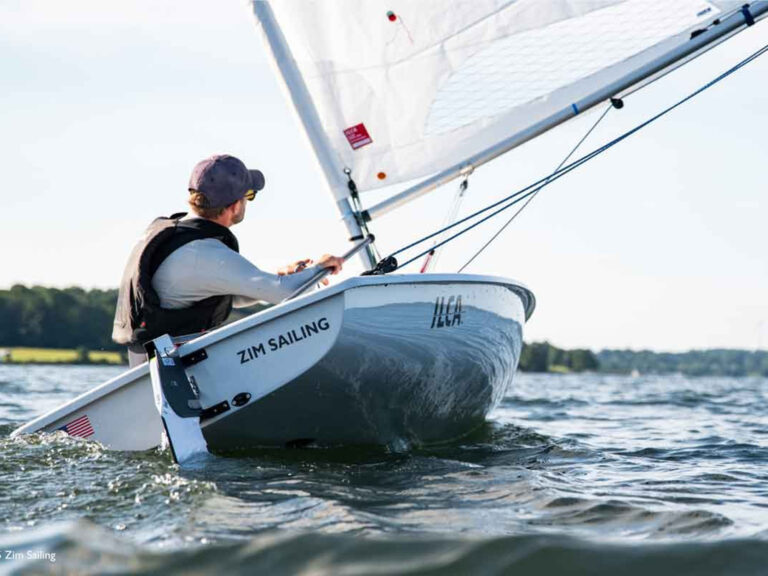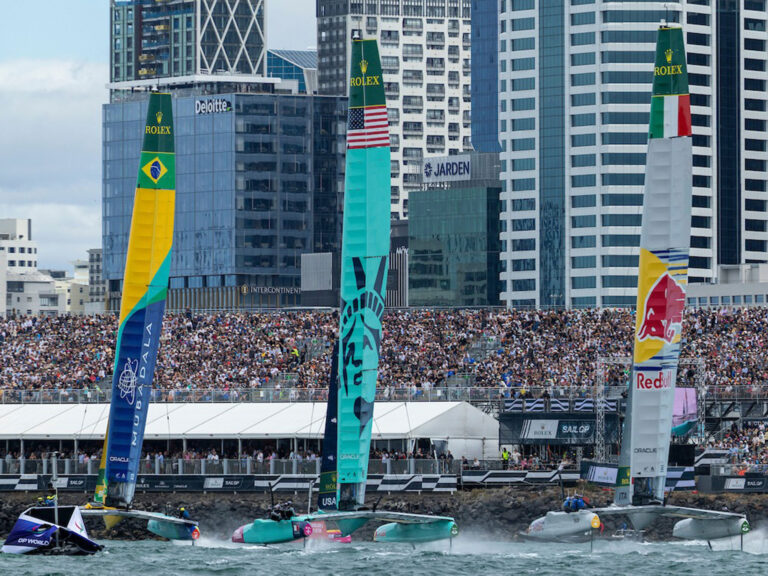
RoseRulesOct05
Over the course of last summer I received a spate of e-mails describing a variety of situations encountered at the offset mark, so this month we’ll look at one scenario. Plus, one reader experienced an unusual kafuffle during a downwind finish, so we’ll look into that as well.An offset mark is a buoy set near the windward mark. Boats are required to round it immediately after they round the windward mark. An offset mark is useful when a windward-leeward course is set. It serves to separate boats beating from boats running and is, therefore, helpful in reducing fouls, protests, and damage when a large, closely matched fleet is racing a short course. In my opinion, the offset mark should be set about 8 to 10 boatlengths from the windward mark so that the short leg between the two marks is a beam reach. I’ll explain why below.For the purposes of this column I’ve invented an incident to help you understand the type of questions that have come to me about offset marks. As shown in Diagram 1, above, two Farr 40s are approaching a windward mark “W.” The offset mark “O” is an inflated ball about 2 feet in diameter and located about 100 feet from W. The course from W to O is a broad reach.Wally and Luke are approaching W on port tack and have overstood mark W by quite a bit. Several boatlengths out, they’re overlapped and headed right for O. At position 1, Wally hails Luke for room to pass to leeward of O. Luke does not reply, holds his course, and does not give Wally room. At the last second, when Wally realizes that Luke is not going to give him room, Wally luffs in an attempt to avoid O. He is unsuccessful. He hits O and the mark rolls down his leeward side. Luke passes just to leeward of O. Wally protests Luke for failing to give room, and Luke protests Wally for hitting O and for passing O on the wrong side. How should the protest committee rule on these two protests?The protest committee should dismiss both protests. Neither boat broke a rule.Let me explain. Rule 28.2 states, “A boat may leave on either side a mark that does not begin, bound, or end the leg she is on.” At the time of the incident, Wally and Luke were on the leg from the starting line to W. Mark O did not begin, bound or end that leg. Therefore, the boats were free to leave O on either side, and so Wally is not penalized for passing to windward of O. Rule 31.1 says, “A boat shall not touch . . . a mark that begins, bounds, or ends the leg of the course on which she is sailing . . .” Therefore, for the same reason, Wally did not break Rule 31.1 when he touched O while on the leg from the starting line to W. So we can conclude that Wally broke no rule.What about Luke? Rule 18 applies “when boats are about to round or pass a mark they are required to leave on the same side, or an obstruction on the same side . . .” As we’ve already seen above, from Rule 28.2, we know that the boats were not required to leave O on the same side. But, was O an obstruction? Applying our example, the definition obstruction would imply that to qualify as an obstruction to a Farr 40, O must be large enough that a Farr 40, when 40 feet from O and headed directly towards it, could not pass it without “changing course substantially.”Because O was a sphere just 2 feet in diameter, a Farr 40 that was 40 feet away from it could easily pass it with just a small course change. Therefore, O was not an obstruction to Wally and Luke. For these reasons Rule 18 did not apply even though Wally and Luke were overlapped and about to pass to leeward of O. Therefore, Luke was under no obligation to give Wally room to pass to leeward of O, and, Luke did not break Rule 18. The only rule applicable in the situation was Rule 11, which required Wally to keep clear of Luke. Wally did so, and therefore neither boat should be penalized.Another question about offset marks comes from reader John Shanholt, who asks, “For the purposes of the rules, is the offset mark actually part of the windward mark?”He noted that, “in recent major regattas there has been only two to four hull lengths between the two marks.” Because the two marks are not physically connected, it seems clear to me that they are two separate objects that “the sailing instructions required boats to leave on a specified side” and, therefore, they are two separate and distinct marks (see the definition Mark).Rule 18 applies as boats round W and then, after that, it applies again as boats round O. Because overlaps must be sorted out at the two-length zone around each mark, race committees should definitely set them several lengths apart so that boats are on a steady and predictable course when they are approaching the zone around O. Also, if the race committee sets W and O close together it defeats the offset mark’s purpose-to separate the boats beating from the boats running. If the leg from W to O is a beam reach, the chances of a situation like the one Wally and Luke encountered is minimized as it’s unlikely that boats will overstand W by so much that they will find O in their path as they sail to W.Kafuffle at the finishOne reader sent us several questions about an unusual finishing incident. It is certainly worth looking into. Five sportboats were running to the finish line on port jibe. The pin end of the line wasfavored. Stu was holding starboard tack and Portia, Paula, and Pam were on port tack. As shown in the diagram at right, all four were overlapped. Stu headeddirectly for the pin hollering “Starboard!” It was clear to the three port tackers that Stu was not about to give them room, and so they all bore off and passed the pin on the wrong side.The race committee did not notice that Portia, Paula, and Pam passed on the wrong side of the pin and recorded them as having finished, i.e., as if they had passed the pin on the correct side. Soon afterwards, Portia turned around and sailed back to the course side of the line across the extension and then crossed the finish line correctly; however, the race committee did not record that event. A variety of protests and requests for redress were lodged, including a request from Oscar who finished just after the four boats involved in the incident. Oscar requested redress under Rule 62.1(a) because the race committee incorrectly scored Portia, Paula, and Pam as having finished ahead of him.Should any of the boats be disqualified? Should any be granted redress? Stu was obligated to bear away and give room to Portia, Paula, and Pam to finish by passing the pin to starboard (see the definition Overlap and Rule 18.2(a)). He did not do so and should be disqualified.The protest committee should grant Oscar’s request for redress and order the race committee to score Pam and Paula DNF and to score Portia in the place she had when she crossed the line, rather than the place she had when she crossed the extension of the line. None of the port tack boats is eligible for redress. Even though Stu broke a rule of Part 2 and hurt the port tackers’ scores, they are not eligible for redress because none of them suffered “injury or physical damage” (see Rule 62.1(b)).E-mail for Dick Rose may be sent to rules@sailingworld.com.





